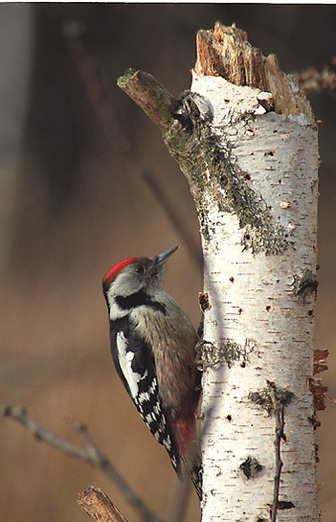Middle Spotted Woodpecker
The Middle Spotted Woodpecker is 20-22 cm long and has plumage similar to the Great Spotted Woodpecker. As with that species the upperparts are predominantly black with white oval wing patches and white barring on the wings, and the underparts are white. The main differences are a red crown, lack of a black moustachial stripe, a pink vent, and dark streaks on the flanks.

Original source: Marek SzczepanekThis illustration was made by Marek SzczepanekIf you are interested in high resolution pictures, please contact author in order to negotiate condition of use.More pictures can be found on here and in the gallery www.naturephotos.com.pl
Author: Marek SzczepanekThis illustration was made by Marek SzczepanekIf you are interested in high resolution pictures, please contact author in order to negotiate condition of use.More pictures can be found on here and in the gallery www.naturephotos.com.pl
Permission: GNU Free Documentation License
The Middle Spotted Woodpecker is classified as Least Concern. Does not qualify for a more at risk category. Widespread and abundant taxa are included in this category.
The Middle Spotted Woodpecker (Dendrocopos medius) is a European woodpecker belonging to the genus Dendrocopos. The Middle Spotted Woodpecker is 20-22 cm long and has plumage similar to the Great Spotted Woodpecker. As with that species the upperparts are predominantly black with white oval wing patches and white barring on the wings, and the underparts are white. The main differences are a red crown, lack of a black moustachial stripe, a pink vent, and dark streaks on the flanks. More
The Middle Spotted Woodpecker occurs only in Europe and southwest Asia, from northern Spain and France east to Poland and Ukraine, and south to central Italy (where local), the Balkan Peninsula, Lithuania, Turkey and the Caucasus. Due to its sedentary nature it has never been recorded in Great Britain. It prefers deciduous forest regions, especially areas with old oak, hornbeam and elm, and a patchwork of clearings, pasture and dense woodland. More
The Middle Spotted Woodpecker lives predominantly on a diet of insects as well as their larvae, which it finds by picking them from branches and twigs rather than hacking them from beneath the bark. It will also feed on tree sap. It is rarely heard drumming, and never for territorial purposes, which it asserts by song; a slow,nasal gvayk gvayk gvayk gvayk gvayk. Calls include a fast kik kekekekek. More
* Middle Spotted Woodpecker: distribution and range * Syrian Woodpecker: distribution and range * Great Spotted Woodpecker: distribution and range * Black Woodpecker: distribution and range * Green Woodpecker: distribution and range * Grey-headed Woodpecker: More
The Middle spotted Woodpecker (mibo) becomes about 22 cm in large. In comparison till the Large spotted Woodpecker, the black line misses above the ear area, and misses the black beard line what is replaced by a black cheek spot. He is also something smaller than the Large spotted Woodpecker. The breast is light of color and has a light black striping til the tail, the belly is pink till the tail. More
View all pictures of Middle Spotted Woodpecker View all pictures of Middle Spotted Woodpecker show section European breeding populations (31) Middle Spotted Woodpecker breeds in the following countries (Bird News Extra subscribers will see population statistics and information on trends for each country): Albania Armenia Austria Azerbaijan Belarus Belgium Croatia Czech Republic Estonia France Georgia Germany More
Middle Spotted Woodpecker icon Middle Spotted Woodpecker (Pic Mar) = Birds > Woodpeckers - by Provence Beyond BEYOND SPLASH 0 Nav Strip - Dendrocopos medius 22 cm - | Woodpeckers | Black Woodpecker | Green Woodpecker | Great Spotted Woodpecker | Middle Spotted Woodpecker | - - Provence More
Middle Spotted Woodpecker call of nestlings from Dendrocopos medius (0:32) Jarek Matusiak XC40840 04-06-2005, Poland Middle Spotted Woodpecker call Dendrocopos medius (0:06) Jarek Matusiak XC41214 05-12-2009, Poland Middle Spotted Woodpecker call Dendrocopos medius (0:05) Jarek Matusiak XC41215 28-11-2009, Poland Middle Spotted Woodpecker call Dendrocopos More
In Switzerland, the middle spotted woodpecker is restricted to mature oak forests. To maintain viable populations of this habitat specialist, specific measures in terms of habitat management are needed. Aims According to the Swiss species action plan for the middle spotted woodpecker, the current population (approx. 500 breeding pairs) and its habitat should be maintained. Additionally, oak plantations should be created to increase future habitat availability and connectivity of the species More
Family : Picidae
Genus : Dendrocopos
Species : medius
Authority : (Linnaeus, 1758)

